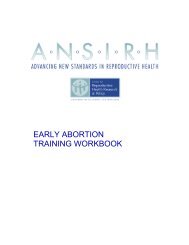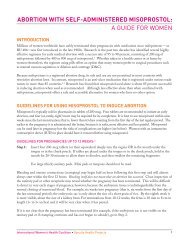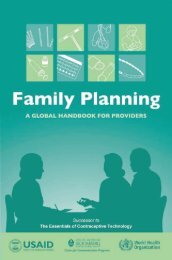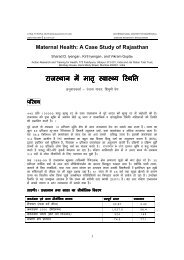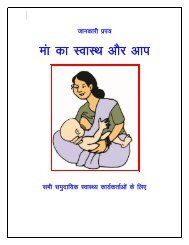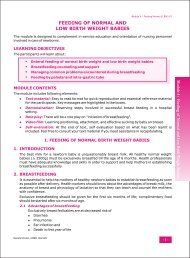Uterine evacuation with manual vacuum aspiration ... - CommonHealth
Uterine evacuation with manual vacuum aspiration ... - CommonHealth
Uterine evacuation with manual vacuum aspiration ... - CommonHealth
You also want an ePaper? Increase the reach of your titles
YUMPU automatically turns print PDFs into web optimized ePapers that Google loves.
❑ If the learners will be divided into groups or will practice at different sites, arrange for additional trainers,<br />
because each learner must be directly supervised by a trainer.<br />
❑ Employ principles of adult learning and maintain a positive learning environment.<br />
Before the Practicum<br />
❑ Identify when caseload at the practicum site is highest. To build caseload, consider asking local facilities to refer<br />
women coming for abortion services to the practicum site during the training period. Alternatively, schedule women<br />
for endometrial biopsy during the practicum and allow learners to perform the procedure, as the skill is similar to<br />
uterine <strong>evacuation</strong>.<br />
❑ Ensure that practicum-site protocols, equipment and supplies are consistent <strong>with</strong> skills to be taught; decide how<br />
to handle any noted discrepancies.<br />
• If necessary, adapt training activities to more closely reflect practicum-site practices, or create additional<br />
activities.<br />
❑ Determine where review and debrief discussions can take place before and after practice. This may be a private<br />
room on- or off-site.<br />
❑ Determine how to keep track of learners who have successfully achieved competency and those who need more<br />
practice, as well as how the latter will receive that additional practice.<br />
During the Practicum<br />
❑ Refer to the Reference Manual frequently during review, debriefing and other discussions <strong>with</strong> learners.<br />
❑ Assign learners to practice procedures according to their skill level.<br />
❑ Assign a few learners and a trainer to work together in ―practice groups.‖ Pair strong learners <strong>with</strong> weaker ones<br />
and ask them to help each other. Once some learners have reached competency, they can help those who have not.<br />
Ensure learners understand what their roles are, what the other learners’ roles are and how to assist other learners.<br />
❑ Limit the number of learners and observers for each procedure.<br />
❑ Obtain the client’s permission for learners to perform the procedure, ensuring she understands that the trainer will<br />
be present and that she has the right to refuse <strong>with</strong>out being denied care.<br />
❑ Always respect the woman’s right to confidentiality and privacy, not only in direct care but also when discussing<br />
her care <strong>with</strong> learners.<br />
❑ Only give corrective feedback to learners in the presence of a client when the mistake could endanger her or<br />
cause her discomfort, in order to limit the anxiety of the client as well as the learner.<br />
❑ Carefully monitor the practicum to ensure that other trainers are following agreed-upon protocols and using the<br />
checklists; to problem-solve issues that arise; to ensure that practice groups are working well; and to make certain<br />
that every learner is getting opportunities to participate.<br />
❑ In addition to leading a debrief discussion, consider seeking feedback from learners after each session.<br />
❑ Use the Clinical Skills Evaluation form in this module for evaluating learners to determine if they can be<br />
considered competent in abortion-care skills.<br />
After the Practicum<br />
❑ Provide the evaluation for learners to complete<br />
❑ Debrief <strong>with</strong> site staff and other trainers about what worked well and how the clinical practicum could be<br />
improved, and thank everyone for their participation.<br />
❑ Provide each learner <strong>with</strong> specific recommendations for implementing and improving their skills when they<br />
return to their sites.<br />
❑ Provide feedback on each learner’s skills to their site supervisor, if appropriate.<br />
❑ Provide opportunities for refresher courses and site-visit exchanges between learners.<br />
❑ Ask the learners what they see as their most important next steps and how you might assist them.<br />
UTERINE EVACUATION WITH MVA: A TRAINING MANUAL FOR CONDUCTING SHORT COURSES Page 32



